 |
Please click here for an update on the expanded DVD versions and here for a further update on the improved Woodstock CD box sets
Summer means outdoor rock festivals, so let's recall the three where it all began – and nearly ended.
Monterey, Woodstock and Altamont have come to represent a short but vibrant and hugely influential life-cycle – the birth, peak and death of a society that was to have been guided by the message of rock and roll. Among them, these three set the stage (so to speak) by introducing the incomparable thrills and crushing disappointments that have marked all other festivals ever since.
Monterey (June 1967) wasn't just a concert, but a celebration with an urgent social agenda – to present music in the context of an emerging culture. The driving force was flower power, a distinctively West Coast movement of inclusive diversity that proclaimed the worth of any positive, life-affirming form of expression. Pluralism flowed through the huge crafts fair that surrounded the arena and through five sessions of eclectic music, which ranged from Simon & Garfunkel's sweet New York harmonies through Canned Heat's Laurel Canyon-infused Delta stomps, Big Brother's searing Texas blues, Jimi Hendrix's mad pyrotechnics, Otis Redding's impassioned soul, the Who's wild British rampage, Hugh Masakela's African roots and Ravi Shankar's flights of exhilarating freedom within the constraints of Indian classicism. Monterey was a non-profit venture and the musicians played without compensation. It was well-planned (with real seats!) and respected all the participants, both performers and audiences, to spread the word to the world outside that these kids indeed were all right and had something important to say. Even the naïve political rants between numbers represented the fervent hope that for their generation correct living and visionary music really could make a difference to foster a better world or, as organizers and musical patron saints Mamas and Papas put it, “California dreamin' is becomin' a reality.”
At Woodstock (August 1969), the disparate strands of Monterey coalesced into a feeling of genuine community, a total life experience of gentle anarchy inspired by revolutionary politics, kindled by music, buoyed by drugs and sustained by love. But despite extensive preparation and capitalistic intentions, Woodstock soon slid into a logistical and financial disaster of crashed fences, irrelevant tickets, depleted food, and vast phone and latrine lines, as bad trips menaced good vibes and mud and garbage smothered the lush fields. Yet, somehow it all cohered through an overriding spirit of support and caring about the things that really mattered. As Joni Mitchell implored in her gorgeous anthem: “We've got to get ourselves back to the garden.” The message that emerged from Woodstock changed a vast number of lives in ways that are still being felt.
With Altamont (December 1969), innocence and idealism came to a crashing end as the harsh reality of the real world burst in. It was intended as a joyous free gala in San Francisco's Golden Gate Park to conclude the Rolling Stones' US tour, but meager planning, shifting logistics and irresponsible security by a motorcycle gang led to chaos and tragedy. The musicians generated huge amounts of sexually-charged energy but found themselves powerless to control the forces of violence they unwittingly unleashed. It was only 3½ months after the ideological triumph of Woodstock where all you needed was love, fresh air and some tunes (and perhaps a hit of acid), but suddenly there was no blissful escape from the harsh failure of a community without structure and the horrible realization that rock couldn't solve society's problems after all.
How do I know all this? I've heard the CDs and watched the movies, of course. For those of us who don't even pretend we were actually there, it is this evidence to which we and future generations must turn for our memories. But rather than preserving an objective record of actual events, like all historical accounts they subjectively mold selective impressions and recollections into persistent myth that ultimately becomes our lasting reality. Just what do these mementos tell us?

Monterey Pop, the movie by D. A. Pennebaker, wasn't the first concert film but, like the festival itself, set the standard structure which others would follow.  There had been lots of movies geared toward the emerging rock market (like the 1956 “The Girl Can't Help It”), but from a condescending vantage of adults bemused by the strange ways of the younger generation. Ironically, even though they were largely irrelevant intrusions into the lame plots and were quite sanitized from the energy and intensity of stage performances, the rock numbers have since become the main points of interest, presenting rare chances to see pioneers like Little Richard and Bill Haley in action. The first movie in which rock took center stage was 1964's T.A.M.I. Show, a TV concert that conveyed the flavor of live theatre shows by dispensing with a silly plot to feature a broad spectrum of English, soul and pop acts from the Beach Boys to James Brown. There had been lots of movies geared toward the emerging rock market (like the 1956 “The Girl Can't Help It”), but from a condescending vantage of adults bemused by the strange ways of the younger generation. Ironically, even though they were largely irrelevant intrusions into the lame plots and were quite sanitized from the energy and intensity of stage performances, the rock numbers have since become the main points of interest, presenting rare chances to see pioneers like Little Richard and Bill Haley in action. The first movie in which rock took center stage was 1964's T.A.M.I. Show, a TV concert that conveyed the flavor of live theatre shows by dispensing with a silly plot to feature a broad spectrum of English, soul and pop acts from the Beach Boys to James Brown.
After the opening credits set the mood over a light show and Big Brother's “Combination of the Two,” the structure of Monterey Pop is largely chronological.  The movie proper opens with scenes of the venue being set up, the organizers dealing with logistical hassles and artists and crowds arriving. Each festival was molded in the image of a single act; Monterey's was coproducer John Phillips' Mamas and Papas (ironically, the blandest act on the entire roster), whose “Creeque Alley” and (of course) “San Francisco (Wear Flowers in Your Hair)” (sung by associate Scott McKenzie) play in the background. Then comes the music, interlaced with brief documentary clips of audience activities and interviews. Finally, there's the departure and clean-up, seen in cutaways from a defining performance. The movie proper opens with scenes of the venue being set up, the organizers dealing with logistical hassles and artists and crowds arriving. Each festival was molded in the image of a single act; Monterey's was coproducer John Phillips' Mamas and Papas (ironically, the blandest act on the entire roster), whose “Creeque Alley” and (of course) “San Francisco (Wear Flowers in Your Hair)” (sung by associate Scott McKenzie) play in the background. Then comes the music, interlaced with brief documentary clips of audience activities and interviews. Finally, there's the departure and clean-up, seen in cutaways from a defining performance.
Just as the event sought to introduce a variety of acts to a national audience, distribution of the Monterey Pop movie was a key step in disseminating rock culture. Nearly all the performers were unknown at the time and owed much of their later celebrity to the exposure afforded by the festival and film. For that reason alone, the movie deserves its cult status.
Yet, with all due respect for its pioneering role and the logistical hurdles it had to surmount, and despite its critical acclaim, the Monterey Pop movie is often disappointing. Much of the synchronization of image and sound is crude and unconvincing. 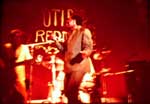 Focus and composition are haphazard. With a single exception, all but the shortest numbers are cruelly cut. Time and again important stage action is lost, covered by seemingly irrelevant crowd shots, undoubtedly not out of artistic choice but because there was no usable footage. (The most frustrating swaps a compelling half-minute of “Ball and Chain” for an inert shot of Mama Cass.) Perhaps as a holdover from the solo-dominated pop era, tight close-ups of lead singers often ignore the rest of a group. (During the Big Brother segment, we barely see anyone but Janis Joplin, especially since the entire instrumental break is cut.) And perhaps inspired by the ubiquitous light shows, some sequences flirt with artiness but emerge as merely incoherent, as when a blinding spotlight keeps obliterating the intended image of Otis Redding. Yet, the home-movie quality lends an aura of awe-struck wonderment and comfortable, engaging intimacy, while even the technical flaws project an appropriate vision of a bold and spontaneous journey down untried paths. Focus and composition are haphazard. With a single exception, all but the shortest numbers are cruelly cut. Time and again important stage action is lost, covered by seemingly irrelevant crowd shots, undoubtedly not out of artistic choice but because there was no usable footage. (The most frustrating swaps a compelling half-minute of “Ball and Chain” for an inert shot of Mama Cass.) Perhaps as a holdover from the solo-dominated pop era, tight close-ups of lead singers often ignore the rest of a group. (During the Big Brother segment, we barely see anyone but Janis Joplin, especially since the entire instrumental break is cut.) And perhaps inspired by the ubiquitous light shows, some sequences flirt with artiness but emerge as merely incoherent, as when a blinding spotlight keeps obliterating the intended image of Otis Redding. Yet, the home-movie quality lends an aura of awe-struck wonderment and comfortable, engaging intimacy, while even the technical flaws project an appropriate vision of a bold and spontaneous journey down untried paths.
There are many indelible performances – the Jefferson Airplane's propulsive “High Flying Bird” and pensive “Today,” Masakela's fervent fusion of African and electronic cultures,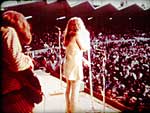 Janis Joplin and Big Brother's frighteningly intense “Ball and Chain,” the Who's destruction of their gear to finish off “My Generation,” Otis Redding squeezing the last drop of passion from “I've Been Loving You Too Long,” and Jimi Hendrix arousing and then immolating his guitar. Despite the hit-and-miss photography, much of the power is derived from seeing these things happen – Joplin completely out of control during her final chorus and then skipping gaily off stage; Country Joe utterly transported by the shimmering sonority of his own music; a terrified stagehand rescuing a mike stand amid the Who's onslaught; and Hendrix somersaulting, playing behind his back and coaxing an entire chorus of “Strangers in the Night” with nothing but feedback. Janis Joplin and Big Brother's frighteningly intense “Ball and Chain,” the Who's destruction of their gear to finish off “My Generation,” Otis Redding squeezing the last drop of passion from “I've Been Loving You Too Long,” and Jimi Hendrix arousing and then immolating his guitar. Despite the hit-and-miss photography, much of the power is derived from seeing these things happen – Joplin completely out of control during her final chorus and then skipping gaily off stage; Country Joe utterly transported by the shimmering sonority of his own music; a terrified stagehand rescuing a mike stand amid the Who's onslaught; and Hendrix somersaulting, playing behind his back and coaxing an entire chorus of “Strangers in the Night” with nothing but feedback.
The movie ends with a bold gesture. After whittling down every other long number, Pennebaker devotes the final 18 minutes (a quarter of the entire running time) to a single piece by Ravi Shankar, enabling his exotic and deeply atmospheric music to build slowly but surely toward an overwhelming climax. As Shankar and tabla player Alla Rakha trade increasingly tight and blindingly fast melodic fragments in a spectacular duet, their focused virtuosity staggers the crowd and trumps their electrified colleagues. A standing ovation brings the film to a rousing (and suitably global) conclusion that drives home the festival's message. (Incidentally, I've based my comments here and throughout this article upon my original 16 mm prints of all three movies, rather than on enhanced or expanded video versions.)
Following the event, LPs were issued of the Shankar, Redding, Hendrix and Mamas and Papas sets. 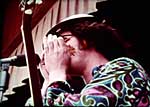 Finally in 1992 came The Monterey International Pop Festival, a magnificent 1992 box set from Rhino, the class act among reissue labels. Like the movie it set a standard but unlike the film needs no indulgence. A beautiful, glossy book with superb images, eloquent commentary and thorough documentation enriches four well-filled CDs which include full or substantial sets by Big Brother and the Holding Company, the Butterfield Blues Band, the Byrds, Jefferson Airplane, Otis Redding, the Who, Jimi Hendrix and the Mamas and Papas and important numbers by Lou Rawls, Canned Heat, and the short-lived Blues Project and Electric Flag. Finally in 1992 came The Monterey International Pop Festival, a magnificent 1992 box set from Rhino, the class act among reissue labels. Like the movie it set a standard but unlike the film needs no indulgence. A beautiful, glossy book with superb images, eloquent commentary and thorough documentation enriches four well-filled CDs which include full or substantial sets by Big Brother and the Holding Company, the Butterfield Blues Band, the Byrds, Jefferson Airplane, Otis Redding, the Who, Jimi Hendrix and the Mamas and Papas and important numbers by Lou Rawls, Canned Heat, and the short-lived Blues Project and Electric Flag.
There are disappointments – missing altogether are Quicksilver, Laura Nyro, Buffalo Springfield and the Dead; Steve Miller had an off-night; the lead vocal mike quit during much of the Blues Project's extended “Wake Me, Shake Me;” Ravi Shankar is reduced to a climactic fragment (different from the movie) that makes little sense without the preceding development; Booker T and the MGs, the Byrds and the Who largely replicate studio versions of their hits; the devastating finales of the Who and Hendrix sets just degenerate into meaningless noise without the shock of their visuals; and while every word uttered by a god may be sacred to true believers, Hendrix's incoherent mumbling between songs testifies that musicians speak through their music.
But only eleven of the 69 numbers replicate those in the movie, the sound is generally fine (even if the mix tends to be a bit bass-deficient and drum-heavy) and the musical highlights are considerable. 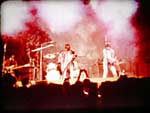 While John Philips later claimed that the Mamas and Papas, exhausted from organizing the festival, “sang the worst they'd ever sung in their lives,” they, the Byrds and the Association sound more spontaneous, enthused and looser than their polished studio output, adding a rare but welcome facet to their artistry. Capped by a stunning “Ball and Chain,” the Big Brother set serves to emphasize that this wasn't just a bunch of stray musicians accompanying a prodigious Janis Joplin, but rather an integral band as the whole group launches into a driving “Road Block” and Janis enthusiastically backs up Sam Andrews on “Combination of the Two.” And despite a rambling and repetitious “Respect,” Otis Redding ignites the crowd with “Shake,” transforms “Satisfaction” into his own personal terms, and after teasingly promising to “drop the tempo” pushes “Try a Little Tenderness” into scorching overdrive, even tacking on a James Brown-type false ending. While John Philips later claimed that the Mamas and Papas, exhausted from organizing the festival, “sang the worst they'd ever sung in their lives,” they, the Byrds and the Association sound more spontaneous, enthused and looser than their polished studio output, adding a rare but welcome facet to their artistry. Capped by a stunning “Ball and Chain,” the Big Brother set serves to emphasize that this wasn't just a bunch of stray musicians accompanying a prodigious Janis Joplin, but rather an integral band as the whole group launches into a driving “Road Block” and Janis enthusiastically backs up Sam Andrews on “Combination of the Two.” And despite a rambling and repetitious “Respect,” Otis Redding ignites the crowd with “Shake,” transforms “Satisfaction” into his own personal terms, and after teasingly promising to “drop the tempo” pushes “Try a Little Tenderness” into scorching overdrive, even tacking on a James Brown-type false ending.
All told, the Rhino Monterey box is a worthy keepsake of the rock festival that started it all, fully regenerating the original audience's joy of discovery and preserving their wholehearted embrace of diverse but universal human values.
The Woodstock movie took the basic format of Monterey Pop and extended its dimensions in every possible way. More isn't always better, but here doubling the running length, screen width and audio channels of its predecessor conveys the soul of the Woodstock Nation with startling effect. Its literal and figurative breadth aptly suggests a complete cultural world and an event of great import.
The fine photography reflects both abundant resources and the professionalism of the cameramen under trying field conditions. A few shots were inventive (the Shwami's warning that America is becoming a hole begins and ends in pans of his vast beard), but most were straightforward and left creativity to editors Thelma Schoonmaker and Martin Scorcese (!). Most acts were covered by many angles, affording an embarrassment of riches from which to choose. (An unfortunate exception was Hendrix's amazing “Star Spangled Banner,” caught by a single camera that dwelled on his impassive face rather than his blazing guitar.) Endowed with two nearly identical shots of Joe Cocker's frighteningly intense workout, or tight close-ups of Stills on one mike and Crosby/Nash sharing another, the editors were able to use them both, rather than having to discard one or frantically switch between them. but most were straightforward and left creativity to editors Thelma Schoonmaker and Martin Scorcese (!). Most acts were covered by many angles, affording an embarrassment of riches from which to choose. (An unfortunate exception was Hendrix's amazing “Star Spangled Banner,” caught by a single camera that dwelled on his impassive face rather than his blazing guitar.) Endowed with two nearly identical shots of Joe Cocker's frighteningly intense workout, or tight close-ups of Stills on one mike and Crosby/Nash sharing another, the editors were able to use them both, rather than having to discard one or frantically switch between them.
That became possible through director Michael Wadleigh's resourceful use of cinemascope, which expands the screen width to nearly double that of the standard 4:3 TV aspect ratio of Monterey Pop. None of the cameras shot in 'scope format, and so the wide frame is used to combine the basic “flat” footage.  Some of the juxtapositions are obvious – the crowd responding to Sly Stone's exhortation to sing, or groups taking up a primal rain chant as drenched kids slide in the mud. Others, though, greatly magnify the mood (lyrical dissolves among far shots of Joan Baez), foster atmosphere (a surreal montage of nighttime headlights and welding arcs during the eerie “Wooden Ships”) or provide sly deflating commentary (kids hawking drugs as local merchants boast of their booming business opportunities; or a couple making love in a field while producer Artie Kornfeld babbles on and on about the deep philosophical significance of the gathering). Complex overlap printing of close-ups and details tracks the density of activity during the Who and Sly and the Family Stone segments and the sheer visceral excitement of Ten Years After and Santana. Some of the juxtapositions are obvious – the crowd responding to Sly Stone's exhortation to sing, or groups taking up a primal rain chant as drenched kids slide in the mud. Others, though, greatly magnify the mood (lyrical dissolves among far shots of Joan Baez), foster atmosphere (a surreal montage of nighttime headlights and welding arcs during the eerie “Wooden Ships”) or provide sly deflating commentary (kids hawking drugs as local merchants boast of their booming business opportunities; or a couple making love in a field while producer Artie Kornfeld babbles on and on about the deep philosophical significance of the gathering). Complex overlap printing of close-ups and details tracks the density of activity during the Who and Sly and the Family Stone segments and the sheer visceral excitement of Ten Years After and Santana.
Documentary sections comprise over a third of the movie. A young couple's vapid views of relationships with each other, parents, politics and life drags on too long,  but the other pieces not only provide a buffer amid the songs but serve to place them in an essential larger context of a complex community molding an event with wide-ranging social significance – standstill traffic, shell-shocked residents, bemused vacationers, torrential rain, yoga, drugs, volunteer medics, lines for phones and the joy of skinny-dipping. Most memorable of all is the Port-O-San man, a Joe Six-Pack guy and a truly fine citizen, who avidly cleans the latrines while noting with pride his two kids – one at Woodstock and the other flying 'copters in Vietnam. but the other pieces not only provide a buffer amid the songs but serve to place them in an essential larger context of a complex community molding an event with wide-ranging social significance – standstill traffic, shell-shocked residents, bemused vacationers, torrential rain, yoga, drugs, volunteer medics, lines for phones and the joy of skinny-dipping. Most memorable of all is the Port-O-San man, a Joe Six-Pack guy and a truly fine citizen, who avidly cleans the latrines while noting with pride his two kids – one at Woodstock and the other flying 'copters in Vietnam.
The reverential tone for the presentation of the acts (and a speech by Max Yasgar, the dairy farmer to whose fields the festival was moved) is relieved by occasional humor - providing bouncing-ball lyrics when Country Joe urges the crowd to sing along; jumping from a barking dog to Joe Cocker; and cutting from a sequence of drug use to a matched shot of a cop eating a popsicle. I've never understood three editorial choices, though.  First, it seems unfair and downright cruel to show sweet, gentle John Sebastian lurching on stage, so wasted he couldn't remember the words to his own song (the poignant “Younger Generation”) when in fact he was a festival hero, volunteering to do an opening set when the scheduled musicians hadn't arrived and tirelessly working to bring acidheads down gently in the “trip tents.” (The CD box presents a far more appropriate tribute with his lovely “Rainbows All Over Your Blues” and “I Had a Dream.”) Second, what's the point of Joan Baez boasting that none of the participants in her husband's prison hunger strike were draft resisters – rapists and child molesters should be turned free as a symbol of social enlightenment? And why snidely subtitle the clear enunciation of the Port-o-San guy – was everyone over 25 a clueless alien? First, it seems unfair and downright cruel to show sweet, gentle John Sebastian lurching on stage, so wasted he couldn't remember the words to his own song (the poignant “Younger Generation”) when in fact he was a festival hero, volunteering to do an opening set when the scheduled musicians hadn't arrived and tirelessly working to bring acidheads down gently in the “trip tents.” (The CD box presents a far more appropriate tribute with his lovely “Rainbows All Over Your Blues” and “I Had a Dream.”) Second, what's the point of Joan Baez boasting that none of the participants in her husband's prison hunger strike were draft resisters – rapists and child molesters should be turned free as a symbol of social enlightenment? And why snidely subtitle the clear enunciation of the Port-o-San guy – was everyone over 25 a clueless alien?
The music is consistently magnificent. Pumped up by the momentous occasion, several performances are definitive – Richie Havens (another hero who unexpectedly performed for several hours that first day) concluding his grueling set with an astoundingly energetic and largely improvised “Freedom,” Joe Cocker spastically clutching his air guitar and screaming his guts out for “A Little Help From My Friends,” Santana blowing the crowds away with their scorching Latin-infused percussion orgy “Soul Sacrifice,” and Ten Years After expanding their supercharged “I'm Going Home” into a compendium of rock history. Crosby, Stills and Nash's kaleidoscopic “Suite Judy Blue Eyes” (only their second live gig), Sly and the Family Stone's manic “Music Lover / I Want to Take You Higher” medley, the Who's wild histrionics, Baez's awesome purity and Hendrix's revolutionary “Star Spangled Banner” are all unforgettable. concluding his grueling set with an astoundingly energetic and largely improvised “Freedom,” Joe Cocker spastically clutching his air guitar and screaming his guts out for “A Little Help From My Friends,” Santana blowing the crowds away with their scorching Latin-infused percussion orgy “Soul Sacrifice,” and Ten Years After expanding their supercharged “I'm Going Home” into a compendium of rock history. Crosby, Stills and Nash's kaleidoscopic “Suite Judy Blue Eyes” (only their second live gig), Sly and the Family Stone's manic “Music Lover / I Want to Take You Higher” medley, the Who's wild histrionics, Baez's awesome purity and Hendrix's revolutionary “Star Spangled Banner” are all unforgettable.
In sharp contrast to the fabulous movie, the Woodstock CD box (the Twenty-Fifth Anniversary Collection, Atlantic 82636) is a disgrace – a cheap (but not inexpensive) and shoddy insult that undermines the import of this vital concert. Trite and sketchy information is clumsily tossed into a thin and brutally ugly booklet. Sound quality for the acoustic material is clear but for the electrified sets is largely devoid of impact. 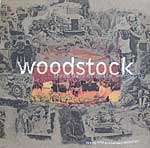 (The mono optical track on my 16 mm print sounds rich and vibrant in comparison.) For a final insult, the CDs run nearly an hour short of capacity and the concluding Hendrix number simply fades out just as he's about to launch into an amazing solo improvisation. (Fortunately, the full Hendrix set is available elsewhere.) (The mono optical track on my 16 mm print sounds rich and vibrant in comparison.) For a final insult, the CDs run nearly an hour short of capacity and the concluding Hendrix number simply fades out just as he's about to launch into an amazing solo improvisation. (Fortunately, the full Hendrix set is available elsewhere.)
Musical disappointments abound – Tim Hardin and Melanie are in rough voice, “Love March” is an atypically lame number from Paul Butterfield, and Mountain, the Band and CCR, fine as they are, largely duplicate their studio hits. But there are some fine additions to the movie soundtrack – Arlo Guthrie's infectious take on Dylan's “Walkin' Down the Line,” Joan Baez's self-penned “Sweet Sir Galahad,” Joe Cocker's highly apposite “Let's Go Get Stoned,” Johnny Winter's scorching “Mean Town Blues,” Janis Joplin's bluesy “Try” and “Work Me Lord” (offsetting a rather slick and perfunctory “Ball and Chain”), a hard-hitting Jefferson Airplane set and five more songs from CSN (including four with Neal Young, who refused to appear in the movie). Fortunately, the stage announcements and intro babble that padded the original 3-LP set (and a 2-LP supplement) are relegated to the end of preceding tracks so they can be skipped. But given the overall frustrations with the box set, it's good that the movie is such a wide-ranging, loving tribute that enhances our perception of this watershed event and capably preserves that memory for future generations

Altamont has no CD box, and it's just as well – the music that survived is rather lame. But the loss is of little consequence, as the movie that emerged, Gimme Shelter, was so potent as to need no aural supplement.
Directors David and Albert Maysles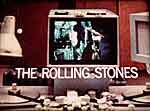 had intended to present highlights of the Rolling Stones' American tour, but came to recognize a far more significant subtext than a bunch of kids enthralled by music. Rather than adhere to the expected chronological approach, co-director Charlotte Zwerin made the inspired and daring decision to restructure their material into a thematic slide from innocence to hell, had intended to present highlights of the Rolling Stones' American tour, but came to recognize a far more significant subtext than a bunch of kids enthralled by music. Rather than adhere to the expected chronological approach, co-director Charlotte Zwerin made the inspired and daring decision to restructure their material into a thematic slide from innocence to hell,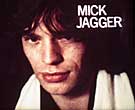 gladly trading factual continuity for a powerful metaphor of a generation precariously slipping on the brink between carefree gratification and mature responsibility. The cameramen (including one George Lucas!) had focused on the telling dynamics of the crowd, and Zwerin wove their material into a rich and profoundly disturbing fabric that deepens with each viewing. All the while, the movie operates on a parallel level as a self-reflexive view of the filmmaking process, constantly reminding us at crucial junctures that we're not viewing a pretense of reality but a manipulation that seeks a deeper level of truth. gladly trading factual continuity for a powerful metaphor of a generation precariously slipping on the brink between carefree gratification and mature responsibility. The cameramen (including one George Lucas!) had focused on the telling dynamics of the crowd, and Zwerin wove their material into a rich and profoundly disturbing fabric that deepens with each viewing. All the while, the movie operates on a parallel level as a self-reflexive view of the filmmaking process, constantly reminding us at crucial junctures that we're not viewing a pretense of reality but a manipulation that seeks a deeper level of truth.
The movie opens with lead singer Mick Jagger strutting his coy sensuality in “Jumpin' Jack Flash” and “Satisfaction” before ecstatic fans at Madison Square Garden. 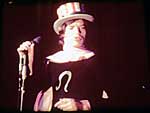 The whole thing's a lark – the Stones prance around their hotel room, banter with the press, joke about their image, listen to a playback of their dreamy “Wild Horses” and float through a surreal, slow-motion “Love in Vain” while pompous attorney Melvin Belli easily parries the logistics of their upcoming tour finale. A few more antics and we'd have a Monkees episode. The whole thing's a lark – the Stones prance around their hotel room, banter with the press, joke about their image, listen to a playback of their dreamy “Wild Horses” and float through a surreal, slow-motion “Love in Vain” while pompous attorney Melvin Belli easily parries the logistics of their upcoming tour finale. A few more antics and we'd have a Monkees episode.
But then the mood sours. Tina Turner does some outrageous things to her microphone and its stand (could the censors who bestowed a PG rating really have been so oblivious?), fans rush the stage, druggies dance in a frenzy, crowd control toughens, scuffles break out, doctors are summoned. Even the garrulous Belli is silenced by an insoluble parking problem.  Increasingly, the kids become joyless and their expressions vacant. First the Jefferson Airplane and then the Stones have to halt their performances, leaving Grace Slick and Mick Jagger to deliver puerile lectures to the crowd to urge calm, but each loses their temper in frustration with their inability to control the raging bedlam. During the perverse history lesson of “Sympathy for the Devil” the portents deepen – a dog crosses the stage, a nude disoriented girl is shoved away, roadies converse tensely and Jagger shocks his disbelieving fans by suddenly stopping his gyrations, freezing and then resuming even more frantically, as if to deny a momentary glimpse of a disquieting omen. Increasingly, the kids become joyless and their expressions vacant. First the Jefferson Airplane and then the Stones have to halt their performances, leaving Grace Slick and Mick Jagger to deliver puerile lectures to the crowd to urge calm, but each loses their temper in frustration with their inability to control the raging bedlam. During the perverse history lesson of “Sympathy for the Devil” the portents deepen – a dog crosses the stage, a nude disoriented girl is shoved away, roadies converse tensely and Jagger shocks his disbelieving fans by suddenly stopping his gyrations, freezing and then resuming even more frantically, as if to deny a momentary glimpse of a disquieting omen.
When the Stones launch into their misogynic “Under My Thumb,” rock and reality fatally collide. In the surging crowd in front of the stage, a Hells Angel struggles to pick up his trampled cycle. Then, in one of the most chilling scenes ever filmed, a cameraman caught another Angel at the side of the stage slowly seething with rage as Jagger sings unaware. 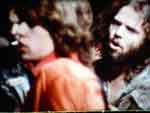 In our hyper-kinetic MTV-spangled modern aesthetic of split-second attention spans and constant sensory overload, we often forget that the boldest editing decision is not to cut at all but to rely on the sustained tension of a single revelatory shot. Here, rather than following Jagger, the cameraman sensed something more significant and instead stayed glued to the fuming Angel, leaving the superstar performer, suddenly irrelevant, to bob in and out of the frame. Unlike the haphazard filming of Monterey Pop or the carefully planned compositions of Woodstock, this shot smacks not only of luck but brilliant intuition, shifting the focus from the intended hub to the real one. And then, right after Jagger modifies the song's concluding lyric to a repeated “I pray that it's all right,” buried in a seemingly random shot from behind him into the crowd comes the infamous murder, too quick to really register. In our hyper-kinetic MTV-spangled modern aesthetic of split-second attention spans and constant sensory overload, we often forget that the boldest editing decision is not to cut at all but to rely on the sustained tension of a single revelatory shot. Here, rather than following Jagger, the cameraman sensed something more significant and instead stayed glued to the fuming Angel, leaving the superstar performer, suddenly irrelevant, to bob in and out of the frame. Unlike the haphazard filming of Monterey Pop or the carefully planned compositions of Woodstock, this shot smacks not only of luck but brilliant intuition, shifting the focus from the intended hub to the real one. And then, right after Jagger modifies the song's concluding lyric to a repeated “I pray that it's all right,” buried in a seemingly random shot from behind him into the crowd comes the infamous murder, too quick to really register.
The finish is as tightly composed as any scripted studio film, a structural marvel that boldly cuts among shots that distill each aspect of the tragic event to its essence. At the same time, the result is packed with symbolism, providing devastating comments on the central dangers of adolescence – pursuing a barren culture adrift on a raft of idealism without social anchors and following leaders with charisma but no soul.
We return to the editing room as an expressionless Jagger studies the murder footage and realizes what had happened – a Hell's Angel repeatedly stabs a fan who brandished a gun. 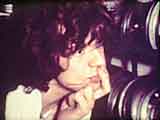 Briefly and blatedly, the Establishment steps in to restore order as the body is borne away on a gory stretcher, a medic describes the fatal wounds and a friend tries to comfort an hysterical witness with socially-correct platitudes. The Stones sing their final lyric, now bitterly ironic (“What can a poor boy do except to sing for a rock and roll band?”), hurriedly say goodbye, are hermetically sealed with their entourage into their helicopter and escape, literally rising above the mess they created and the disciples they're deserting. Bereft of idols or their energizing music, kids descend a dark hill in silence, groping their way down toward an uncertain destination (and destiny). Briefly and blatedly, the Establishment steps in to restore order as the body is borne away on a gory stretcher, a medic describes the fatal wounds and a friend tries to comfort an hysterical witness with socially-correct platitudes. The Stones sing their final lyric, now bitterly ironic (“What can a poor boy do except to sing for a rock and roll band?”), hurriedly say goodbye, are hermetically sealed with their entourage into their helicopter and escape, literally rising above the mess they created and the disciples they're deserting. Bereft of idols or their energizing music, kids descend a dark hill in silence, groping their way down toward an uncertain destination (and destiny).
Reduced to a mere bystander, Jagger impassively rises to leave the editing room. The camera zooms into his blank face, searching in vain for any sign of emotion. The hushed soundtrack explodes with the Stones' “Gimme Shelter” but, as the lyrics suggest, any hope for genuine refuge is a mere illusion amid a world in turmoil.  As if to illustrate the song's desperate vision of a bleak apocalypse, groups of kids stride by, clinging to the failed political symbol of a red flag and the neo-religious hope of a gods-eye. The penultimate shot, as they pass in front of a blinding sun, is stunning in its multiple levels of ambiguity. Is the sun rising or setting? No matter – nature is eternal and indifferent to social trends or human needs. Who are these kids? We can't tell – the sun melds their individual forms into an anonymous mass, just as their struggle to become distinctive and idealistic adults is about to be swamped by the pressures of conformity and convention. Where are they going? That we do know – it's the rock generation passing by in revue, even as its dreams had nearly passed away. As if to illustrate the song's desperate vision of a bleak apocalypse, groups of kids stride by, clinging to the failed political symbol of a red flag and the neo-religious hope of a gods-eye. The penultimate shot, as they pass in front of a blinding sun, is stunning in its multiple levels of ambiguity. Is the sun rising or setting? No matter – nature is eternal and indifferent to social trends or human needs. Who are these kids? We can't tell – the sun melds their individual forms into an anonymous mass, just as their struggle to become distinctive and idealistic adults is about to be swamped by the pressures of conformity and convention. Where are they going? That we do know – it's the rock generation passing by in revue, even as its dreams had nearly passed away.
Rock all but died after Altamont – not literally, of course, but the ideals of Monterey and Woodstock soon lapsed into bland repetition. It would be years before punks and independents revitalized rock with a raw, creative vigor that recalled its birthright of rebellion, energy and sex. But that's another story.
Update:
the expanded DVD releases
The DVD of the 1996 Woodstock “Director’s Cut,” while moderately priced, has none of the extra features we’ve come to expect from that format, and the visuals dissipate the visceral power of theatrical presentations by jumping disconcertingly among various aspect ratios (and cramming the ‘scope sections into a narrow slit on conventional TV screens). 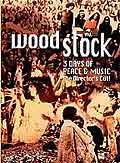 Yet, even so reduced, the images immeasurably enrich the impact of forty minutes of additional music. Canned Heat (whose “Goin’ Up the Country is only heard as background in the original release) pumps out “Leavin’ This Town” with huge kinetic enthusiasm that transcends the persistent, tedious arrangement (although it’s caught with a single continuous mobile shot that often finds itself at an awkward angle behind the action). After Grace Slick’s “morning maniacs” introduction, the Jefferson Airplane (wholly absent from the original) slips into “Saturday Afternoon/Won’t You Try,” whose tentative, incoherent sound is clarified by shots of Grace, Marty and Paul searching to blend their complex vocal lines; it’s unclear, though, why Jorma’s “Uncle Sam Blues” is marred by a cut that excises much of the second verse and instrumental, since the full number was recorded; even if footage was missing, gaps in the visuals for Janis Joplin’s grindingly intense “Work Me Lord” are covered by stills montages rather than deletions. Best of all is the Hendrix sequence, greatly expanded to include “Voodoo Chile” and the entire final 15 minutes of his set (which closed the festival – following, of all things, Sha-Na-Na!), adding the complete searing “Purple Haze” and a wildly inventive solo improvisation. As in the original release, “Villanova Junction” is used only as background to the cleaning-up sequence and his famous “Star Spangled Banner” is shot in extreme but rather useless close-up, so the added material fully displays and documents the astoundingly confident and bizarre Hendrix technique. Yet, even so reduced, the images immeasurably enrich the impact of forty minutes of additional music. Canned Heat (whose “Goin’ Up the Country is only heard as background in the original release) pumps out “Leavin’ This Town” with huge kinetic enthusiasm that transcends the persistent, tedious arrangement (although it’s caught with a single continuous mobile shot that often finds itself at an awkward angle behind the action). After Grace Slick’s “morning maniacs” introduction, the Jefferson Airplane (wholly absent from the original) slips into “Saturday Afternoon/Won’t You Try,” whose tentative, incoherent sound is clarified by shots of Grace, Marty and Paul searching to blend their complex vocal lines; it’s unclear, though, why Jorma’s “Uncle Sam Blues” is marred by a cut that excises much of the second verse and instrumental, since the full number was recorded; even if footage was missing, gaps in the visuals for Janis Joplin’s grindingly intense “Work Me Lord” are covered by stills montages rather than deletions. Best of all is the Hendrix sequence, greatly expanded to include “Voodoo Chile” and the entire final 15 minutes of his set (which closed the festival – following, of all things, Sha-Na-Na!), adding the complete searing “Purple Haze” and a wildly inventive solo improvisation. As in the original release, “Villanova Junction” is used only as background to the cleaning-up sequence and his famous “Star Spangled Banner” is shot in extreme but rather useless close-up, so the added material fully displays and documents the astoundingly confident and bizarre Hendrix technique.
The Gimme Shelter DVD (Criterion, 2000) strikes a middle balance between the bounty (and expense) of Monterey Pop and the meager adds (and economy) of Woodstock.  Both sound (in Dolby stereo and surround) and picture (in the original 1.33:1 “TV” aspect ratio) look fine; a restoration demo shows the ironic inferiority of the 35mm theatrical prints, degraded by being blown up from the original 16mm materials. A rambling commentary track by co-directors Albert Maysles and Charlotte Zwerlin is numbingly vapid, so devoid of insight as to challenge the extraordinary bold intelligence with which I credit their work. Extras include over an hour of the day-after KSAN radio wrap-up broadcast, each of the dozen excerpts introduced by original host Stefan Ponek, dozens of still photos by Bill Owens and Beth Sunflower, and three outtakes from Madison Square Garden, all in good sound but very raw workprints, with dirty leader filling the gaps between missing visuals. Of these, “Little Queenie” is rather labored, but with plenty of Jaggerisms and a long take of Charlie Watts, who’s usually ignored in the background. “Carol” is a more assertive rendition, but poorly-lit and -shot. Best of all is an acoustic “Prodigal Son,” with just Mick and Keith, harshly lit, but shot skillfully with a single camera. We also get a five-minute rehearsal room segment in which Jagger plays some guitar blues with the approval of Ike and Tina Turner. Both sound (in Dolby stereo and surround) and picture (in the original 1.33:1 “TV” aspect ratio) look fine; a restoration demo shows the ironic inferiority of the 35mm theatrical prints, degraded by being blown up from the original 16mm materials. A rambling commentary track by co-directors Albert Maysles and Charlotte Zwerlin is numbingly vapid, so devoid of insight as to challenge the extraordinary bold intelligence with which I credit their work. Extras include over an hour of the day-after KSAN radio wrap-up broadcast, each of the dozen excerpts introduced by original host Stefan Ponek, dozens of still photos by Bill Owens and Beth Sunflower, and three outtakes from Madison Square Garden, all in good sound but very raw workprints, with dirty leader filling the gaps between missing visuals. Of these, “Little Queenie” is rather labored, but with plenty of Jaggerisms and a long take of Charlie Watts, who’s usually ignored in the background. “Carol” is a more assertive rendition, but poorly-lit and -shot. Best of all is an acoustic “Prodigal Son,” with just Mick and Keith, harshly lit, but shot skillfully with a single camera. We also get a five-minute rehearsal room segment in which Jagger plays some guitar blues with the approval of Ike and Tina Turner.
As with the audio box set, the 2002 Criterion Monterey Pop DVD set is by far the most elaborate and extensive (and costly) of the three. 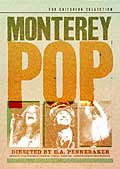 The first of three discs has the original movie with vastly enhanced sound and insightful commentaries by director Pennebaker and producer Lou Adler, plus lots of interviews, stills, radio spots and the original program. There's also an informative 64-page booklet that provides balance for the consistently upbeat impression of the movie. The second disc contains two featurettes with the full Otis Redding and Jimi Hendrix sets; although this material is all in the box set, the experience is greatly enhanced by the visuals of Otis’s intensity and Hendrix’s dynamism - the instrumental breaks in "Hey Joe" are swell enough to hear, but astounding when seen played behind Jimi's back and with his teeth! But the real prize is the third disc – two hours of outtakes from the movie, including fine performances by the Association, the Blues Project, the Paul Butterfield Blues Band, Quicksilver Messenger Service, the Electric Flag, the Byrds, Laura Nyro and Buffalo Springfield, none of whom appeared in the theatrical release, together with additional numbers from Simon & Garfunkel, Country Joe and the Fish, the Jefferson Airplane, Big Brother and the Holding Company, the Who and the Mamas and the Papas, plus a dubious bonus of Tiny Tim. Performances and photography fall well short of definitive quality, but given the dearth of documentation of these seminal groups’ performances of the era, it’s all most welcome. The first of three discs has the original movie with vastly enhanced sound and insightful commentaries by director Pennebaker and producer Lou Adler, plus lots of interviews, stills, radio spots and the original program. There's also an informative 64-page booklet that provides balance for the consistently upbeat impression of the movie. The second disc contains two featurettes with the full Otis Redding and Jimi Hendrix sets; although this material is all in the box set, the experience is greatly enhanced by the visuals of Otis’s intensity and Hendrix’s dynamism - the instrumental breaks in "Hey Joe" are swell enough to hear, but astounding when seen played behind Jimi's back and with his teeth! But the real prize is the third disc – two hours of outtakes from the movie, including fine performances by the Association, the Blues Project, the Paul Butterfield Blues Band, Quicksilver Messenger Service, the Electric Flag, the Byrds, Laura Nyro and Buffalo Springfield, none of whom appeared in the theatrical release, together with additional numbers from Simon & Garfunkel, Country Joe and the Fish, the Jefferson Airplane, Big Brother and the Holding Company, the Who and the Mamas and the Papas, plus a dubious bonus of Tiny Tim. Performances and photography fall well short of definitive quality, but given the dearth of documentation of these seminal groups’ performances of the era, it’s all most welcome.
Further Update:
A Better Woodstock Box!
Fifteen years after release of the inept Atlantic 25th anniversary travesty, Rhino came to the rescue with Woodstock 40 Years On: Back to Yasgur’s Farm.  As we have come to expect from Rhino, the presentation is superb – the six CDs are full (ranging from 77 to nearly 80 minutes, as opposed to Atlantic’s four that ran over an hour short of capacity), stage announcements are separately tracked (and thus skippable if, as for me, hearing them once is more than enough) and the 80-page book is filled with informative text, relevant photos and a full program listing. The only bummer: the astounding Ten Years After “I’m Going Home,” the Band and ten other tracks from Tim Harden, Arlo Guthrie, Canned Heat, Creedence Clearwater Revival, Janis Joplin, Jefferson Airplane, Crosby, Stills, Nash and Young and Jimi Hendrix have been dropped, whether as a matter of editorial judgment or, as producer Andy Zax gingerly puts it in his introductory article, due to “some rather non-Aquarian logistical realities” (translation: licensing greed). As compensation, the discs include much music that was previously unreleased from Sweetwater, Bert Sommer, Quill, The Incredible String Band (all omitted from previous Woodstock LPs and CDs), Tim Hardin, Ravi Shankar, Arlo Guthrie, Mountain, the Grateful Dead, the Who, Country Joe and the Fish, Johnny Winter and Sha-Na-Na. The Who’s “We’re Not Gonna Take It” is extended to full length and Guthrie’s “Coming Into Los Angeles” and Mountain’s “Blood of the Sun” and “Theme For an Imaginary Western” are the actual Woodstock cuts rather than other versions previously misrepresented and substituted (Guthrie is far off-mike for much of his song). Frankly, I could have done without the interminable (actually 28 minutes) Canned Heat “Woodstock Boogie” and Country Joe and the Fish’s meandering reprise of their “Rock and Soul Music” (a mere 12), both of which sorely tried my patience, but that's just me. (Only the Keef Hartley Band remained absent.) All is presented in the actual order heard at the festival. All in all, it's a wonderful souvenir/educational resource of this seminal event in our culture . As we have come to expect from Rhino, the presentation is superb – the six CDs are full (ranging from 77 to nearly 80 minutes, as opposed to Atlantic’s four that ran over an hour short of capacity), stage announcements are separately tracked (and thus skippable if, as for me, hearing them once is more than enough) and the 80-page book is filled with informative text, relevant photos and a full program listing. The only bummer: the astounding Ten Years After “I’m Going Home,” the Band and ten other tracks from Tim Harden, Arlo Guthrie, Canned Heat, Creedence Clearwater Revival, Janis Joplin, Jefferson Airplane, Crosby, Stills, Nash and Young and Jimi Hendrix have been dropped, whether as a matter of editorial judgment or, as producer Andy Zax gingerly puts it in his introductory article, due to “some rather non-Aquarian logistical realities” (translation: licensing greed). As compensation, the discs include much music that was previously unreleased from Sweetwater, Bert Sommer, Quill, The Incredible String Band (all omitted from previous Woodstock LPs and CDs), Tim Hardin, Ravi Shankar, Arlo Guthrie, Mountain, the Grateful Dead, the Who, Country Joe and the Fish, Johnny Winter and Sha-Na-Na. The Who’s “We’re Not Gonna Take It” is extended to full length and Guthrie’s “Coming Into Los Angeles” and Mountain’s “Blood of the Sun” and “Theme For an Imaginary Western” are the actual Woodstock cuts rather than other versions previously misrepresented and substituted (Guthrie is far off-mike for much of his song). Frankly, I could have done without the interminable (actually 28 minutes) Canned Heat “Woodstock Boogie” and Country Joe and the Fish’s meandering reprise of their “Rock and Soul Music” (a mere 12), both of which sorely tried my patience, but that's just me. (Only the Keef Hartley Band remained absent.) All is presented in the actual order heard at the festival. All in all, it's a wonderful souvenir/educational resource of this seminal event in our culture .
I should also note that 2019 brought several 50th anniversary packages from Rhino, including, at long last, a massive set that seems as complete as will ever be, comprising 36 hours on 38 CDs (each act on its own disc, with a few spilling over onto a second, together with lots – lots – of stage talk (all 17+ minutes of Sri Swami Satchidananda professing that "Music is the celestial sound," anyone?). A limited edition of 1,969 copies (clever!), it sells for an outrageous premium; a more affordable version is a ten-CD set with many different songs than on 40 Years On (and it includes Ten Years After and the Hartley Band). In the meantime, for those dissatisfied with excerpts but interested in specific acts, several key complete Woodstock sets have been released on separate CDs, including Creedence, Janis, Jefferson Airplane, Santana, Johnny Winter and Sly and the Family Stone. So ... you pays your money and takes your choice …

Copyright 2003, 2004, 2010 and 2019 by Peter Gutmann
|
